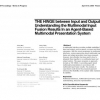Free Online Productivity Tools
i2Speak
i2Symbol
i2OCR
iTex2Img
iWeb2Print
iWeb2Shot
i2Type
iPdf2Split
iPdf2Merge
i2Bopomofo
i2Arabic
i2Style
i2Image
i2PDF
iLatex2Rtf
Sci2ools
CHI
2008
ACM
2008
ACM
The hinge between input and output: understanding the multimodal input fusion results in an agent-based multimodal presentation
| Added | 30 Nov 2009 |
| Updated | 30 Nov 2009 |
| Type | Conference |
| Year | 2008 |
| Where | CHI |
| Authors | Yong Sun, Helmut Prendinger, Yu (David) Shi, Fang Chen, Vera Chung, Mitsuru Ishizuka |
Comments (0)

